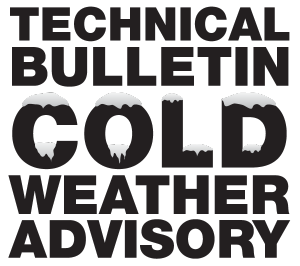Technical Bulletin: Cold Weather Advisory
This bulletin is to inform customers about the “best practices” for shipping, handling, storing and installing VersaFlex Polyurea systems during cold weather/winter conditions.
While VersaFlex makes no guarantee that following these guidelines will result in a more usable product, it is our estimation that these suggestions should be touchstones for best practices during the parts of the year with cold weather.

For all VersaFlex Products: Polyurea SL/Joint Filler & Spray Systems:
Shipping:
Shipping material during the cold winter months will reduce the internal temperature of the material and therefore will need to be warmed to recommended temperature levels prior to installation/application.
Storage:
Temperature Conditions: minimum of 60 degrees F to 95 degrees F, (18 degrees C to 35 degrees C).
Installation:
Temperature Conditions: It is recommended the material temperature be a minimum of 70 Degrees F, or higher. It is also recommended that a Laser Temperature Gun be available for accurate temperature readings before and during installations.
For cold (on-site) environments it is important to keep material in heat boxes or heated rooms. Installing material where ambient conditions and/or floor temperatures are below 60 degrees, material should be stored at 70 degrees F or above. The utilization of tank heaters/blankets and hose line heat tape is useful in maintaining the proper material temperature.
In cooler temperatures material viscosity is increased which puts more strain on proportioning equipment. Monitoring and maintaining recommended temperatures is a simple way to reduce the risk of processing issues that lead to additional costs.
Additional Notes:
- The cold makes it difficult for people to move and work for long periods of time.
- The cold typically changes the way that materials are applied, making paints or similar viscosity materials thicker and harder to work with.
- Applying the material on a cold surface will sometimes cause the material to freeze, or thicken to the extent that it is difficult or impossible to apply. This is somewhat less of a problem with our hot spray systems, but the common sense here applies nonetheless.
- Moisture can freeze on the surface, causing serious application problems and premature coating failure.
- The material may not properly cure, or stay soft for long periods of time.
- Be sure it can’t wait. It will always be easier to apply in warmer weather.
- Consider the substrate you’re coating. Metallic (non-porous) substrates will be easier to coat than wood and concrete (porous) substrates. Wood and concrete will be much more challenging to determine if the surface is damp.
- Do some research. You may ask us if we have “cold” or “fast” cure systems that will be more appropriate for your application. (We probably do.)
- Follow the technical data sheet documents closely. Read and understand the application directions.
- Be sure the material will cure. Some materials, like epoxies, will begin curing as the temperature warms up, and slow down or stop curing, as the temperature drops. Be sure you understand the type of material you’re using and don’t apply a material that will take two weeks to cure, especially if it’s going to get rubbed or damaged in the meantime.
- Be sure the surface is dry. This can be the most challenging problem because you may not be able to see if the surface is dry, particularly if it’s below 32°F. A nice trick is to take an area to which you want to apply the coating, and safely warm it up (you can use your hand). Take a tissue, place it on the surface and place you hand over the tissue. The heat from your hand will cause any ice to melt, and you’ll see the dampness on the tissue.
Of course, you can always use supplemental heat to warm the area or asset you’re trying to coat. If you do this, be very, very careful if you’re working in a confined space and pay attention to the substrate temperature, not the air temperature. That is, if you’re coating a fire hydrant, and you build a tent around the hydrant, don’t check the air temperature, check the temperature of the steel.







